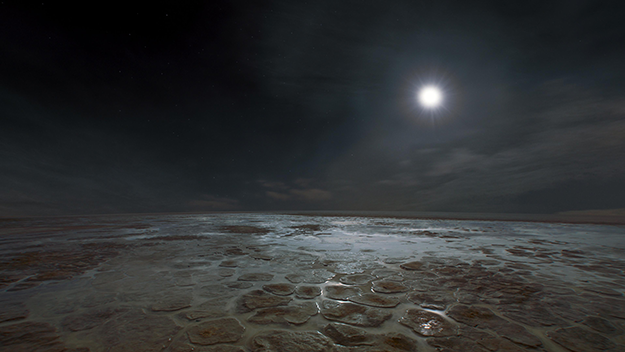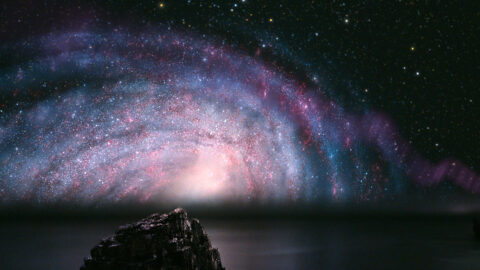Festivals: Toronto

Voyage of Time: Life’s Journey
One shouldn’t force connections among the films one sees at a festival, and certainly not at one as bursting at the seams with movies of differing temperament and quality as the Toronto International Film Festival, but it’s perhaps worth noting that Voyage of Time: Life’s Journey and The Human Surge captured my imagination in unexpectedly similar ways. The former is the most maximalist work yet by the U.S.’s most unabashedly big-thinking film artist, Terrence Malick, that never lets the audience lose sight of the big questions at its heart; the latter is an oblique work of interstitial moments and the first feature by Argentinean experimental filmmaker Eduardo Williams. It’s hardly worth enumerating why these are wildly different projects in form and in the kinds of emotional effects they aim to elicit in the viewer (reductively, untrammeled awe for Malick, obfuscated desire for Williams). Worth exploring, instead, are the similarities, if only to underline how a film’s perceived accessibility or lack thereof is largely beside the point when it comes to one’s emotional or intellectual enjoyment of it.
Both mix textures in surprising ways: The Human Surge, separated into three sections from three different continents, features footage shot on 16mm, Super 16mm filmed off a computer monitor, and digital video on the RED camera for a more recognizably smooth, contemporary look; Voyage of Time: Life’s Journey begins, most viewers would be surprised to find, with images of homeless, scavenging Americans shot on low-grade cell-phone video, and continues to weave other degraded, barely composed video images from countries around the world into its larger tapestry of gorgeous, meticulously constructed wonders detailing nothing less than the creation of the universe and the birth of life. Both refuse to engage in any particular characters’ subjectivity, preferring a detached, almost omniscient perspective, even if Malick’s film elides the presence of the camera completely and Williams always gives you the sense that someone is watching. And both are essentially wide-ranging films daring to engage the viewer in big questions about the condition of contemporary existence, yet the experience of watching them complicates any simplistic reading.
For all its wordless abstraction, Malick’s film, a 90-minute extrapolation of the 20-minute creation-of-the-world sequence from The Tree of Life, is in a way his most cleanly linear film, moving inexorably from galactic pools of light and primordial gas cloud formations to splitting amoebas, underwater creatures, and galumphing dinosaurs. As anyone who was appropriately agape at The Tree of Life will expect, all of these are pure astonishments, and, for this viewer at least, it was often difficult to see what was the product of CGI, chemistry-lab experiments by special-effects masters Dan Glass and Douglas Trumbull, or good old-fashioned nature footage. As intoned by Cate Blanchett, with the same hushed command she gave as the narrator of the Lord of the Rings films (one momentarily expects to see Galadriel shimmering out of the darkness during her opening words over a black screen), Malick’s much-practiced, metaphysically inquisitive voiceover sounds more melancholy than ever.

The Human Surge
“Mother, you walked with me in the silence, before there was a world, before night or day, alone in the stillness, where nothing was…” Such words will inevitably strike some viewers as either too hand-holding or philosophically diaphanous. But such earnest stargazing seems to me to fit right in with the traditions of spiritual inquest that led from Job to St. Thomas Aquinas to Heidegger to Stanley Kubrick’s 2001: A Space Odyssey. For Malick, the scientific facts of creation, from Big Bang to the meteoric decimation of the dinosaurs to early hominids, are not mutually exclusive from secular query. Unlike The Tree of Life, with its more openly Christian imagery, Voyage of Time: Life’s Journey feels largely nondenominational, though it had better be, due to its globe-hopping, taking in images of struggle from multiple continents. Malick is eternally concerned with the existence of violence and the persistence of beauty, underlined by the aching sadness of Blanchett’s narration working in counterpoint to its succession of visual glories. (A 45-minute IMAX version narrated by Brad Pitt is also forthcoming, though it reportedly functions only as a kind of schoolroom narrative, eliminating Malick’s more abstract gambits.) For those like me who remain unutterably moved by The Tree of Life’s less-than-10-second image of a mortally wounded plesiosaur craning its endless neck to a silent, unforgiving sky, Voyage of Time: Life’s Journey will be strong stuff. All others, go hunt for more modest pleasures.
From the extraordinary to the seemingly ordinary: The Human Surge is disinterested in the kinds of humongous moments Malick trades in, but it feels similarly monumental. Charting a course from Argentina to Mozambique to the Philippines that’s driven by nature and technology in equal parts, Williams makes mincemeat of all narrative conventions and confounds even art-film expectations. The untethered nature of the film’s form extends to the camerawork itself, struggling to keep up even with its principal actors, often bumpily trailing behind them as they wind their way through urban or rural environments that feel labyrinthine and decontextualized. In the first sequence, in Buenos Aires, we follow a rootless young man during the in-between moments of his day after losing his job at a warehouse, browsing the Internet, hanging out with other unemployed friends, and lackadaisically taking part in a gay-for-pay webcam show with a group of apathetic buddies. This last act, graphically yet so casually captured as to eliminate any sense of undue voyeurism, connects us to a group of similarly wandering boys in Maputo, also trading in their bodies for emotional validation and digital cash, but mostly out of boredom. And after traveling directly into an anthill, its bustling workers in hectic close-up, the camera emerges into a jungle in the Philippines, where an extended scene of bathers gives way to a young woman’s potentially fruitless journey through a rural village to find a cyber café.
For a film seemingly interested more in bodies and the space they traverse than the particular lives those bodies lead, The Human Surge registers as a surpassingly empathetic work; even its aggressively inhuman final sequence, set in a tablet computer factory, somehow managed to move me, representing an incontrovertible shift toward a new kind of labor, built to feed an insatiable need for human connection through technology. At the end, we hear the nattering repetition of a computerized voice (“Ok, ok, ok”), apt for a film about people moving through life in circles, whose value is difficult to ascertain in a global economy predicated on cryptic, often non-monetary exchange.

Yourself and Yours
Unlikely global interconnections and small people caught in major international events are at the center of writer-director Nacho Vigalondo’s Colossal, an ungodly rom-com/addiction drama/monster-movie hybrid that plays like Days of Wine and Roses crossbred with Pacific Rim. Starring Anne Hathaway as a shiftless alcoholic thirtysomething whose self-destructive rampages have catastrophic effects on not only her own life but also thousands of others’ (specifically in South Korea, for reasons impossible to summarize without sounding like a loon), the film is metaphorically sound while making no literal sense. Which would be fine if Vigalondo were nimble enough a dramatist, or strong enough a director of actors, to effectively peddle his goofy wares. There are some true laughs here and there (most of them courtesy of whatever department put together the film’s very amusing succession of Facebook posts and TV news headlines), and its scenario plays as a good joke on big-budget motion-capture filmmaking, but the whole thing gets bogged down in clunky monologues, repetitive scenarios, and a performance of forced every-guy nonchalance by Jason Sudeikis that has to be seen to be disbelieved. On the plus side, after giving its heroine the romantic option between two jerks (Sudeikis and Dan Stevens, batting those famous baby blues), Colossal at least allows her to walk away from both in dramatic, girl-power fashion.
The narrative similarities between Colossal and the latest from Hong Sangsoo, Yourself and Yours, are literally only occurring to me right now as I write this (and they have nothing to do with South Korea). Each kicks off with a romantic breakup initiated by a man accusing a woman of drinking too much, starting a chain of ambiguous events involving what seems to be a bizarre case of doubling. In Yourself and Yours, Min-jung (Lee You-young), walks out on boyfriend Young-soo (Kim Joo-hyuck) upon feeling unduly attacked by him after he hears secondhand news of her soju-soaked misadventures around town, which she denies. Soon enough, Min-jung is being approached by a series of other men, to whom she denies that she is Min-jung at all, claiming to be her twin sister. Not allowed to find out whether Min-jung really is a twin, the viewer, like the film’s increasingly amusing chain of befuddled men, is left to wonder exactly what’s going on. Of course, as always with Hong (and all good art), the what is less important than the why, and Yourself and Yours is slowly revealed as another nimble investigation into the communication barriers men and women often erect between each other. It’s alternately caustic and sweet, leading to one of Hong’s most hopeful conclusions. And since cautious optimism can feel like a complete triumph at a film festival, Hong’s film was a beautiful way to leave Toronto.




